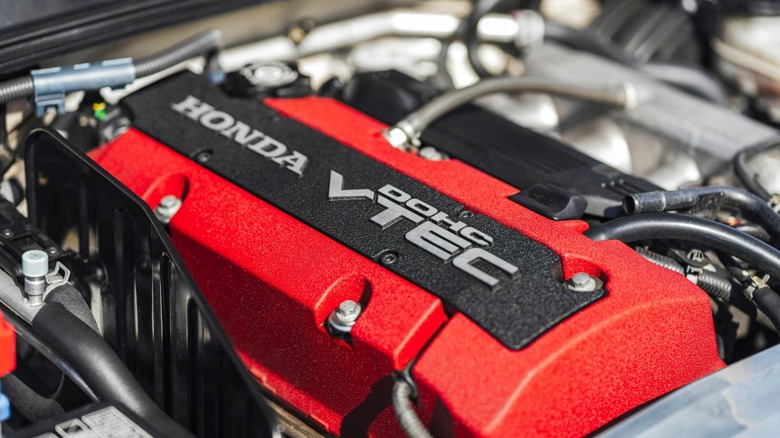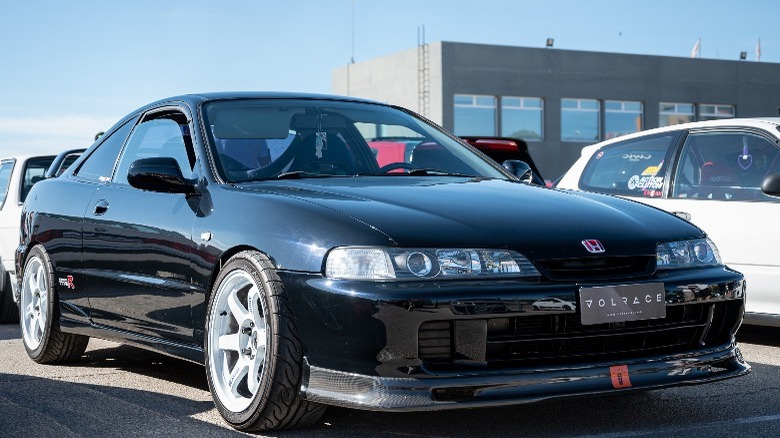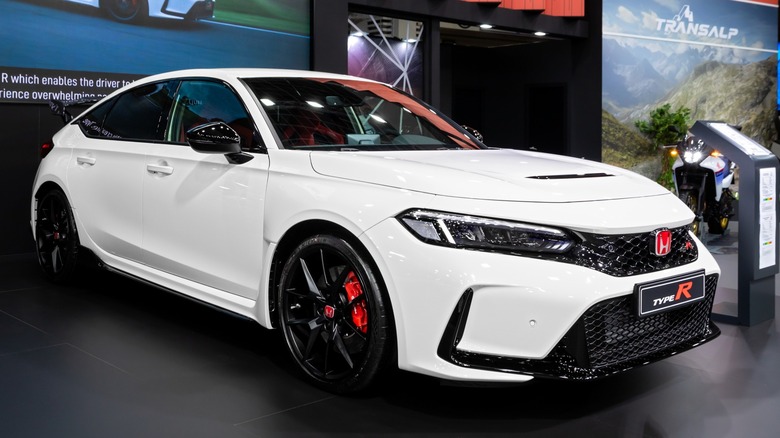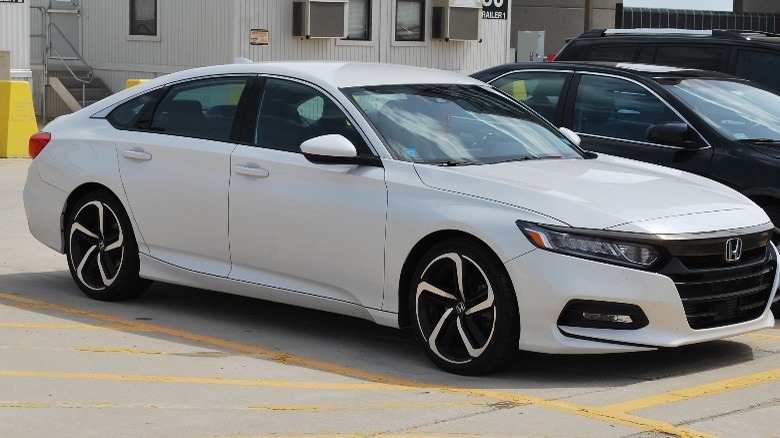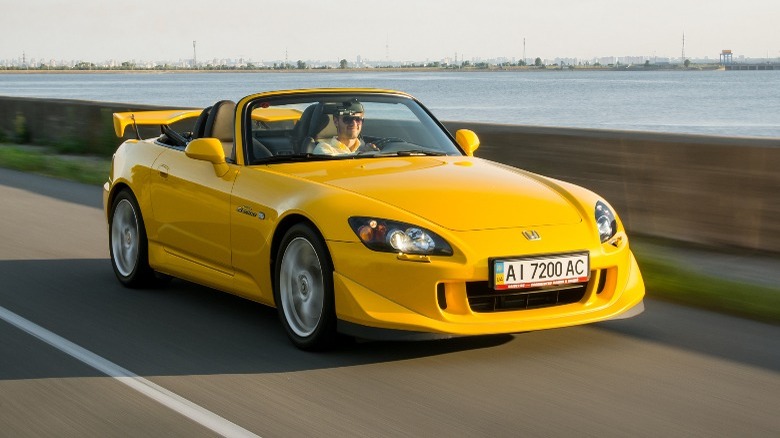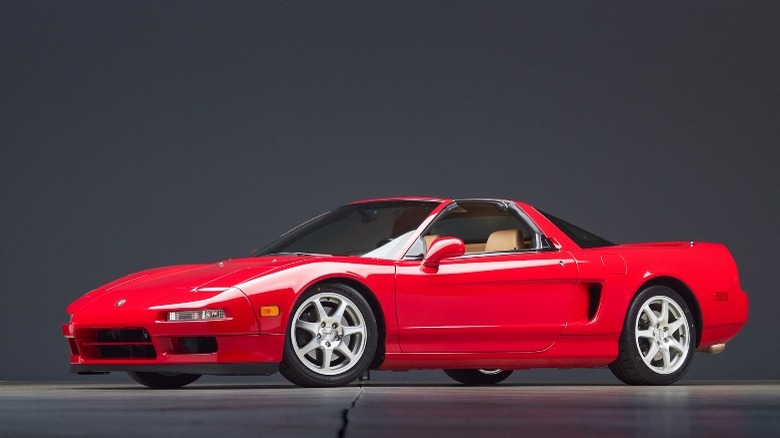Honda's Fastest Models With VTEC Engine Technology
While Honda wasn't the first car brand to introduce variable valve timing (VVT) to the motor world, it certainly took it to another level. Honda's iconic VTEC (Valve Timing and Lift Electronic Control) technology gleaned inspiration from Alfa Romeo's mechanical variable valve timing system, which, in hindsight, is one of the biggest discoveries of the automotive industry. The Japanese company used computers and various cam profiles to improve it and make it a much more potent solution to squeezing performance from engines with smaller displacement.
The first car in Honda's VTEC history to use VVT was the 1989 Acura Integra XSi model. It had a naturally aspirated 1.6-liter four-cylinder engine with VTEC on both its exhaust and intake cams. This car somehow managed 160 hp at 7,600 rpm, which is incredible for such a small engine from the late '80s.
VTEC is so effective at boosting performance because it allows more air to get into and escape the combustion chamber when it detects that the car needs to "breathe" more at high speeds. While riding, you can even physically feel the velocity change and exhaust sounds when the car engages the VTEC, and that's the origin of the "VTEC just kicked in, yo!" meme.
Since its introduction, Honda has used this technology to create iconic sports cars. We've compiled a few of the fastest, so you know which ones top the chart.
Acura Integra Type R (Third Generation)
Some say the third-gen Honda/Integra Type R is the best FWD car of all time. Articles from car journalists worldwide have placed it on a pedestal, and it has remained there even as newer, more modern roadsters have come and gone.
This car was sold in the U.S. with the Acura Integra Type R nameplate (Honda Integra in other markets) as a performance-oriented trim option in the Integra lineup. Honda produced it from 1994 to 2001, after which the Acura Integra was renamed RSX. If you popped the hood open on one of these, you'd see what you might think was a disappointing engine by today's standards, but don't let looks fool you. The Integra Type R had a 1.8-liter DOHC VTEC four-cylinder engine that managed a magical 195 hp at 8,000 rpm.
Honda stripped out air conditioning, cruise control, sunroof, and visor mirrors and generally built the car lighter than its non-R counterparts. Its lightweight disposition, combined with the high-revving B18C5 VTEC engine, gives this FWD a 6.1-second zero-to-60 (according to Zero to 60 Times) and a drag-limited top speed of 143 mph (according to Car and Driver). Going by William Clavey of Jalopnik's account, the ITR's VTEC kicks in at about 5,500 rpm. But where the Integra R really shines is its handling. The limited-slip differential, sturdy steering system, improved brakes, and a host of other core tunings have also earned it a title as the best-handling front-wheel drive car ever.
Honda Civic Type R (FL5)
The Honda Civic Type R has earned a long and respected history since the "EK" Civic was upgraded for the Type R badge in 1997. However, the CTR has come a long way since then, and the new FL5 Civic Type R is pushing hot hatches into supercar territory.
For the uninitiated, the FL5 is the chassis code for the latest CTR models (2023 and 2024). While Honda's flagship FWD sports car now has an understated design, it piled more of the aggression into the engine. Said engine is a turbocharged 2.0-liter four-cylinder DOHC VTEC engine that outputs 315 hp at 6,500 rpm and 310 lb-ft of torque. It's tagged as "the most powerful Civic Type R ever" right there on Honda's official website.
Car and Driver's tests indicate that the 2023 CTR can reach 60 mph from a standstill in 4.9 seconds and has an advertised top speed of 171 mph. Motor Trend's speed tests weren't as fruitful as this, though, and their runs with the 2021 CTR Limited Edition resulted in a better quarter-mile timestamp and top speed number. In a more prepared scenario, the preproduction 2023 Honda Civic Type R beat the 2021 CTR LE's track record in 2022 at the Suzuka Circuit. It also holds the record as the fastest FWD on the Nürburgring.
Honda Accord 2.0T (10th Generation)
There isn't really a "single" model called a Honda Accord 2.0T. Instead, this is an umbrella designation for all the 10th generation Honda Accords with the 2.0-liter turbocharged engine. Even though it's kind of sad to see Honda's legendary J35 V6 engines replaced with four cylinders, these turbocharged VTEC inline-4s really carry on the torch.
The 10th-generation Accords span from the 2018 to 2022 models, and all of these years allow you to get the sedan with either 2.0-liter or 1.5-liter engines. The 2.0-liter cars have 252 hp at 6,500 rpm, 273 lb-ft of torque, a dual overhead cam (DOHC), and could be paired with a six-speed manual, 10-speed automatic, or continuous variable transmission (CVT) system. If the engine sounds familiar, that's because it's a dumbed-down version of the Civic Type R's.
All of these specs make this seemingly modest mid-size family sedan surprisingly fast. It can reach zero to 60 mph in 5.5 seconds and beat the quarter mile in 14.1 seconds. It also has an electrically limited top speed of 126 mph, according to Car and Driver.
Honda S2000 Club Racer
Honda has perfected the art of FWD, but don't forget that it's also dipped its toe into the RWD pool — with great success. Enter the Honda S2000, a car ahead of its time, a true roadster that embodied Honda's oft-neglected history of racing and performance. This car was built to rival the Porsche Boxster, but the Boxster is nowhere close in value and cult following this car has amassed.
The engine sitting atop the S2000 was called the F20C. It was a 2.2-liter inline-4 VTEC DOHC engine rated at 237 hp at 7,800 rpm and 162 lb-ft of torque at 6,800 rpm, paired with a six-speed manual transmission. Honda was quite proud of these numbers, and it stated that no other engine had more power per liter. This convertible came with a Club Racer (CR) option with wider wheels for greater tire contact patch, making for better traction, and it was lighter than the base model. Nowadays, these CR S2000s are coveted and could go as high as $70,000.
Frankly, this convertible's numbers were a little lower than the competition's at the time. But its light framework and nimble nature tagged it with a curb weight of around 2,800 lbs. Motor Trend's road tests prove that the S2000 can reach 60 mph from a standstill in 5.8 seconds, and it beat the quarter mile in 14.2 seconds. Better numbers than both its rivals, the Porsche Boxster and BMW Z3.
Acura NSX (First Generation)
The Acura NSX is Honda's first true supercar, one that can compete shamelessly with Ferraris and Lamborghinis of a similar era. It's the inspiration for the McLaren F1, whose designer, Gordon Murray, loved the car so much that he owned one for personal use. The Acura NSX is such a rare, beloved car that it holds the position of the Holy Grail for Honda and VTEC fans.
Sales for this vehicle ran from 1990 to 2005. In 1997, Honda upgraded the displacement in the engine, taking it up from the 3.0-liter C30A engine to the 3.2-liter C32B engine. The 3.2-liter model is called NA2, and the 3.0-liter model is called NA1. For the purpose of this list, we'll focus on the NA2 model since it has more power.
According to lore, the NSX was the first production car to have an all-aluminum alloy chassis and suspension. This made the car exceptionally light. Coupled with its engine, a mid-rear mounted naturally-aspirated V6 VTEC DOHC engine that managed 290 hp at 7,100 rpm gave this RWD a 4.9-second zero-to-60 and a top speed of 175 mph (according to Car and Driver). It also beats the quarter mile in 13.3 seconds.
Honda made multiple versions of the NSX, like the NSX-R and NSX-R GT. Some were modified and used for races. Famously, the NSX competed in the 24 Hours of Le Mans in 1994, 1995, and 1996 — and it won the GT class division in 1995.
